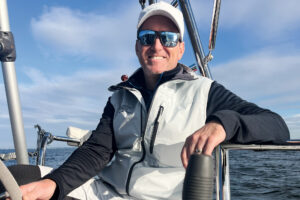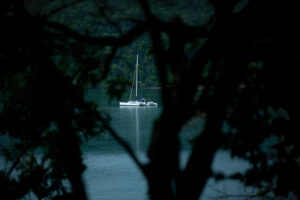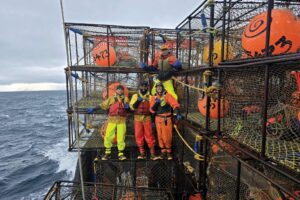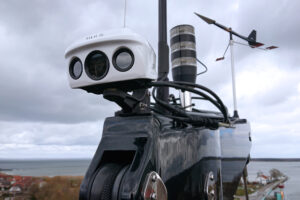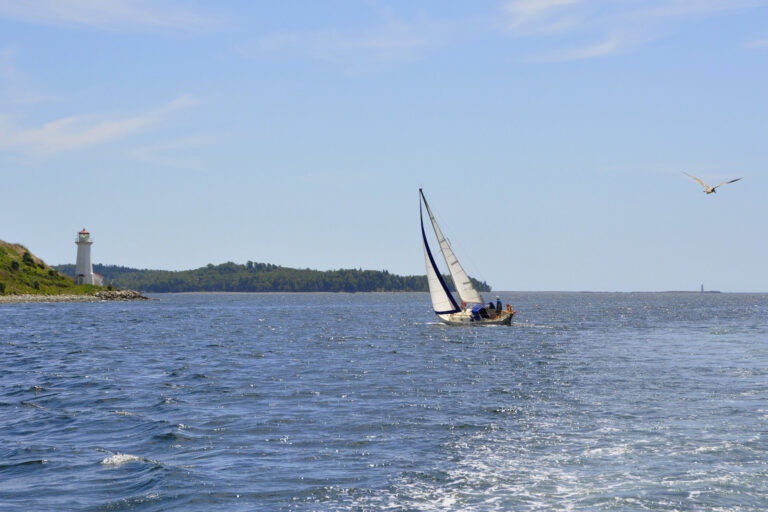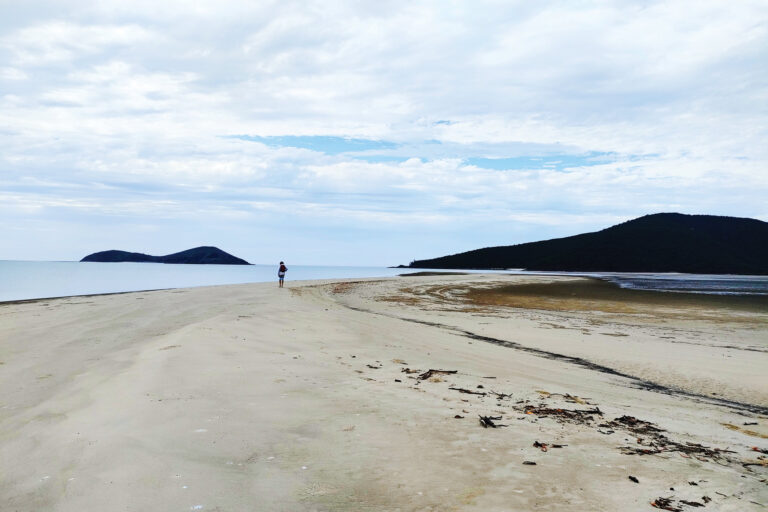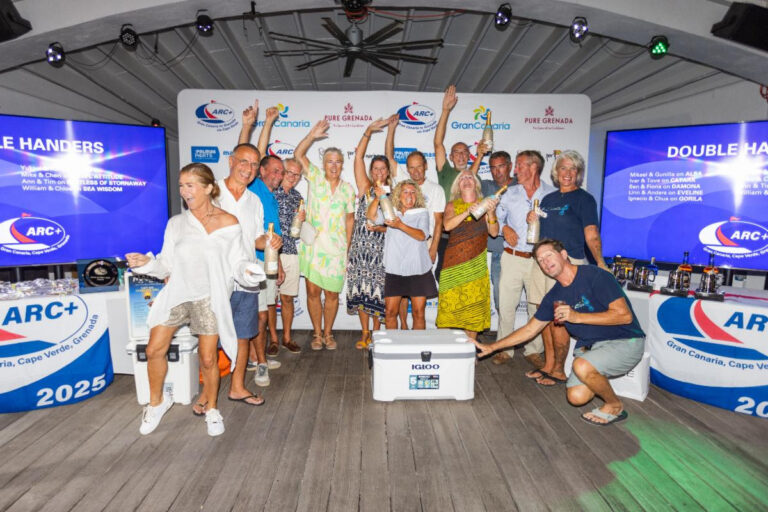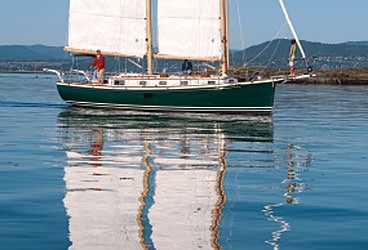
Jakatan 368
Schooners aren’t sailing made simple. The two concepts of easily handled rigs and historically complex schooner sail plans just don’t jibe. So when a client approached designer Bob Perry with the task of creating a contemporary two-masted gaff-rigger that would be easy to sail yet stylish with a legacy rig, Perry had his doubts. But then again, this was no ordinary client.
Jeff Hawkins is a product engineer of the highest order. Among his achievements, he founded Palm and revolutionized mobile computing. And before long, his ground-breaking neuroscience research on brain function may do the same with computer intelligence, and it might just completely change our world.
No stranger to great thoughts, Jeff had set his mind to yacht design, and with his unique ideas, he had Perry’s attention. The result of their interaction was a new sort of schooner that was soon on the drawing board.
“I first thought, ‘Why a schooner, when it should really be a cutter?'” Bob recalls. “But the more I tried to impose my impression of what I thought he wanted, the more I realized he had a distinct image in his head of what it should look like.”
Jakatan is a 40-foot composite-built schooner that draws some of its design elements from the San Francisco schooner scows. With carbon spars and gaffs, a spade rudder, and a foam-cored hull, it’s a high-tech creation, an aesthetically engineered modern cruiser. Jakatan was built by Jespersen Boat Builders in Sidney, on Vancouver Island in British Columbia.
Jeff brought firm priorities to the project: “One requirement was that it serve as a fun daysailer and be comfortable for windy San Francisco Bay,” he says, outlining his design brief. “But more than that, it was to be a modern cruising boat, not a replica. Easy to sail and having attractive lines, the schooner was to be inspired by tradition but not be a boat to prompt remarks that it was quaint and historical.”
Jeff went to Robert H. Perry Yacht Designers Inc. to find a designer experienced with modern cruising ideas and possessing an eye for sheer and for overall style. There were other naval architects with more historical bents who’d infuse their designs with traditional character, but Jeff wanted a balance between modern and traditional.
“I’ve designed hundreds of boats, but I really bonded with this project,” Bob says. “Jeff was demanding and savvy and could read the drawings. I was being called upon to do my best work, and I was personally challenged to produce a new schooner that was no clone of the past. It’s unique.”
The designer shelved any ideas that might involve borrowing lines from the Volvo 60s or Open 40s and melding them with a schooner rig. Instead, he worked toward a classic sheer, a modern hull shape with only five and a half feet of draft, considerable displacement, and volume. As expected, traditional schooners bring a lot of baggage to the present-day design brief. When you factor in the expectations of a modern-day interior in a hull that’s less than 50 feet, you typically sacrifice the traditional sheer on deck because classic schooners had headroom in the saloon of only five feet 11 inches, and less forward. There was no pressure for interior living space in the old days, but Jakatan, from its inception, was meant to be a family-friendly cruiser capable of season-long, extended-distance coastal cruising in often-blustery waters.
A Talented Builder
Eric Jespersen grew up in British Columbia, sailing off the coast and building powerboats and sailboats of all types with his dad, Bent, who began his boatbuilding career in Denmark. After decades of work, the elder Jespersen turned the business over to Eric more than 10 years ago. The shop, filled to the rafters with memorabilia from generations of successful projects-from 12-Meter and 6-Meter racing sloops to luxury pilothouse cruisers-is often ankle deep in cedar shavings, and it’s endowed with the spirit of craftsmen who today split their time about evenly between new builds and complicated repairs that few other shops could master.
“I went to Eric because his company had one shed and they’d focus all their attention on my project,” Jeff says. “They do great work, with their hearts in it, and the shop and Sidney, B.C., offer a fun atmosphere. I also wanted to be able to visit the boatyard and fly back to the Bay Area within the same day.
Jakatan’s hull was laid up with three layers of red cedar strips on either side of one-inch Core-Cell coring, then vacuum bagged and epoxy glassed with biaxial unipoxy. Awlgrip was applied to the hull’s exterior. The decks are a composite of okoume plywood and foam core.
Hall Spars made Jakatan’s masts and gaffs from carbon fiber; sails came from UK-Halsey. On deck, Harken hardware-including the furler and a mixture of manual and electric winches-makes for family-friendly sailhandling.
Modern by design and construction and owned by a skipper with a command of computer wizardry at his fingertips, Jakatan goes to sea without being loaded down with gadgetry on board. The nav station is humble and functional, with Raymarine navigation instruments, and other systems include refrigeration, hot water, and a propane fireplace.
The interior is crafted in warm, inviting teak and yellow cedar. Solid and superbly built, Jakatan’s joinery includes exposed beams and bead boarding on half bulkheads; the handiwork rivals the boat’s engineering prowess. Belowdecks, the two masts are surprisingly unobtrusive because they straddle the main cabin and leave the dining area uninterrupted. The layout is ideal for a family, with one large head, a spacious shower, a roomy saloon with a wraparound settee, and a quarter berth with an ingenious headboard design that doubles as the nav station’s seat back. Many man-hours went into little aspects of the design, from the specified shelf size to accommodate a bedside box of tissues to the 12-degree angle of the headboard for reading in bed to the contours of the dining settee and the galley recycling center.
Topside, attention to detail abounds as well. A fold-out transom swim platform with a ladder folds flush into the aft deck. Removable davits are made from carbon fiber, and for long passages, the twin-mast configuration is ideal for on-deck dinghy stowage in between. The foredeck features a large, flush, dedicated fender locker in which deck gear can be quickly stowed. There’s even a small cockpit locker, also accessible from below, for binoculars, radios, and other small items. All the hatches are screened, providing lots of natural ventilation below, and the oversized cockpit deck hatch is designed so that the engine can be removed in one piece.
“I think we had three guys brainstorming for a week over the adjustable locking bench seats for the main saloon,” laughs Eric. “We really thought that one out.”
All that planning, coupled with top-notch craftsmanship, serves up a cozy traditional feel below and a clean schooner rig topside, with a spacious cockpit and sweet design elements at every turn.
For cruising under power, Jakatan sports a Volvo Penta 75-horsepower diesel with a saildrive and a Max-Prop.
From start to finish, the construction of Jakatan took just less than two years. This relatively short schedule for such an ambitious project is a testament to the faith the builder, designer, and owner had in each other’s abilities and contributions to the finished schooner.
“We knew from the start that this owner was hands-on like no other with whom we’ve worked,” says Eric. “He relished the creative process, so much so that each step, from the design to build, was more like a think-tank decision.”
When a question arose or a decision was needed, Jeff created memos and needs analyses, and he’d race back and forth with very detailed specifics about everything except, perhaps, the underwater hull form and construction methods. On these, he deferred to the experts, Perry and Jespersen.
“A lot of clients build custom boats and have no idea what they’re doing,” says Eric. “We’re left to resolve complicated and sometimes subjective issues on our own. We liked working with Jeff, who rolls up his sleeves and comes up with opinions and the engineering talent to back them up.”
“I design products for a living,” Jeff notes. “I like solving problems.
“This was a personal project,” he continues. “If I enjoy sailing the boat half as much as I enjoyed building it, I’ll be thrilled.”
An Owner with Ideas
Jeff Hawkins grew up around boats in Centerport, New York, on Long Island, in a house that had more shop space than living space. Of his father and two brothers, he’s the only one who today doesn’t live on a boat. His father was a design engineer with a passion for unusual craft, and together the family (his mom was also handy in the shop) constantly tinkered with boats and developed an unusual flotilla.
When Jeff was 5, his father built a 16-sided, air-cushioned craft with a Hyperlon-type fabric skirt that floated on a bubble of air provided by three vacuum-cleaner motors; it looked like a Martian spacecraft and was marketed to the U.S. Navy. The 50-ton craft had eight retractable legs and a drawbridge-like ramp. It would zip up at high tide, drop the legs, raise the skirt, and deploy the drawbridge, offering temporary shoreside floating space. The boat eventually spent several summers touring Connecticut, Long Island, and Manhattan, and it traveled up to Albany with a 50-piece symphony orchestra playing free concerts aboard. Fellini couldn’t have choreographed anything stranger, but such a creation was sort of routine for this creative family.
While his father went on to develop floating hotels, floating campers, floating toilets, and even floating homes, Jeff and his brothers put sailing first. He rebuilt a Lightning while his brother built a Blue Jay. They also owned a wooden Honeymoon sloop, a once-sunken 45-foot South Bay sloop, and others.
Jeff moved to the San Francisco Bay area and completely restored a pretty Geary 18 in a year and a half. Too late, he realized that the boat was too flat and just wrong for the high winds and chop of the Bay. It was a setback, but a few years later, now with a wife and kids of his own, he was bemoaning the little sailing he’d done lately when his brother gave him the solution.
“He said to forget about wooden boats and restoration projects,” says Jeff. “He told me to just buy an easy-to-sail fiberglass boat with lots of light and room below for the kids to play. Go out on sunny days and put it where it is fun to sail, and soon your family will share your sailing interest.”
Jeff did just that. “Owning a fiberglass boat was difficult for me initially,” he says, “but 12 years of sailing a Nonsuch with my family around San Francisco convinced me that my brother was right, and it also inspired the evolutionary concept for Jakatan.”
The Challenge for a Designer
Jakatan was a detail-driven project. Careful deliberation was given to each feature: how the lazarette holds equipment, how the removable davits run cleanly into the deck, how the swim step folds cleverly out of the transom, how the table in a wide cockpit serves as a foot brace, how a fender locker is built flush into the foredeck.
One creation crucial to the design was the single-halyard hoist system to be used for the gaff-rigged spars.
“I wouldn’t have built this boat,” Jeff says, “if each sail had to have the traditional two halyards, one for the gaff peak and one for the throat. It would’ve been too laborious to handle, and the key element was an easy-to-sail rig.”
So the gauntlet was on the table: Could the collective brain trust come up with a state-of-the-art single halyard to raise and lower the gaff rig?
Typically, when a schooner is under way, the crew adjusts the peak and throat halyards independently on different points of sail. Jeff, though, believed that wouldn’t be needed with today’s vangs, stiff spars, low-stretch lines, and modern sailcloth; he thought that one could maintain the proper gaff angle once the sails were up without needing the ability to reset the booms. Aboard Jakatan, a track on the gaff permits the peak angle to be set before the hoist. Just in case, there are blocks rigged for a second halyard, but so far, at all angles of sail and in light to heavy breezes, this single-line system has worked fine.
To keep the workload under sail to a minimum, topsails were never an option, and Perry’s first drawings came back showing a very high-peaked rig. It was a classic look, but Jeff didn’t want the profile of a New York Yacht Club 1930 racing schooner. He wanted a low-angle gaff with a three-sail rig that would be simple and powerful, like the working San Francisco scows.
The elimination of running backstays-a traditional schooner hallmark-was another engineering decision made to ensure that the boat would be easy to sail. The design collaborators knew they wanted substantial-sized masts to create aesthetic balance, so why not build them strong enough to forgo all that extra hardware and work? As a Nonsuch owner, Jeff had no fear of big sails and unstayed masts-he knew they’d work. But when the mast maker wouldn’t guarantee it in every condition, the answer was simply to add attachment points on the mast should runners be needed; in reality, Jeff’s plan was to draw straws to see who’d rig it at the height of a raging storm. “We worked to eliminate the obstacles people associate with schooners,” Jeff says.
Jakatan Puts to Sea
Jakatan was created not for charter but for a family with kids. It features a very large cockpit with no companionway threshold, so while it isn’t ideal for ocean crossings (although it would likely handle a crossing better than most boats of its size), it’s ideal for taking friends around San Francisco Bay. Its stated strength is coastal cruising, allowing Jeff and his family to plan sailing trips for a month or two here and there-from the Inside Passage in the summer to Baja in the winter, and maybe swing across to the U.S. East Coast for a summer or two in Maine and on the Chesapeake.
The boat displays a tasteful amount of exterior brightwork-without overloading maintenance chores-and is designed to be maintained by the owner.
Under sail, Jakatan, with its plumb bow, long waterline, volume, and fine entry, is stiff; she cleaves through the seas with a schooner’s strength and reaches well. The balanced rudder handles the large sail aft, keeping the boat responsive without weather helm. The boat cruises effortlessly at eight knots. While a cutter may have been closer winded, the lightweight construction, spade rudder, and shapely underbody make Jakatan one of the liveliest and most intriguing schooners afloat these days.
“With all its design parameters and unique rig, Jakatan was eagerly anticipated by my office with hope and curiosity, and we were all pleasantly surprised at how responsive the overall feel was,” says designer Perry. “Perhaps it was the larger, Nonsuch-styled main that inspired thoughts of a new boat with a divided sail area and schooner rig, but it worked. It’s fun to drive, and when we sailed it, the harder it blew, the more we all wanted to be on the helm.”
One day last summer, with Jakatan about to set sail for a cruise through Canada’s Gulf Islands, Bob and Jeff stopped by the Jespersen shop to finish up plans for a tender. The sparks were flying as the collaboration gave birth to a rowing and sailing dinghy with a low center of gravity, the ability to store the sail rig on board, and a seat that could slide into perfect position relative to the rower. As the ideas emerged, one could imagine the memos flying back and forth and the needs analyses, the strategy sessions, and the think-tank conclusions that were all part of the process.
Looking at Jakatan and listening to the give-and-take, I couldn’t wait to see what would emerge from that shop next.
Neil Rabinowitz is a Puget Sound-based marine, travel, and sports photographer who occasionally picks up the pen when the spirit moves him.

